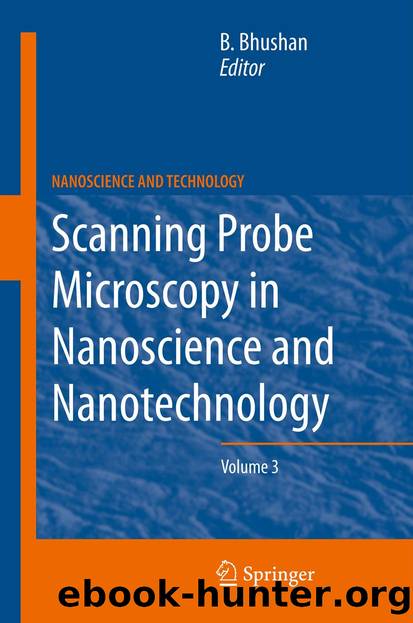Scanning Probe Microscopy in Nanoscience and Nanotechnology 3 by Bharat Bhushan

Author:Bharat Bhushan
Language: eng
Format: epub
Publisher: Springer Berlin Heidelberg, Berlin, Heidelberg
It clearly appears that, after complete relaxation (24 h), a surface corrugation is created (Fig. 11.4a). The spatial frequency determined on the topography picture is in full agreement with the frequency of the interference pattern used to create the grating, determined by the angle between the two incident beams. The origin of the surface corrugation will not be discussed here. Basically, it results from the inhomogeneous densification of the sample due to inhomogeneous irradiation [34].
The stiffness picture related to the Young’s modulus distribution on the free polymer surface is depicted in Fig. 11.4b. The bright areas on the picture are characteristic of the areas with maximum stiffness, e.g., with the highest polymerization ratio. These lines coincide with those of maximum intensity received by the material. The adhesion picture presented in Fig. 11.4c is also similar to the topographic pattern. This result proves that a local modification of the adhesion was induced by the laser irradiation. In the present case, the influence of the surface relief on the stiffness and adhesion responses can be neglected since the height of the protuberances (typically 60 nm) is much smaller than their lateral dimension (typically 1,000 nm). Since the three images were recorded during the same scanning of the surface, it is possible to correlate the information on topography, stiffness, and adhesion without introducing any problem related to the piezo drift from an image to another one. This first example illustrates the potential of PFM/AFM that is well suited for characterizing domains with different mechanical properties. Indeed, the technique is sensitive enough to detect structural differences that are induced by irradiation. The intrinsic resolution of AFM is much higher than the one needed to analyze such structures. Consequently, this method can be used to evidence heterogeneities at polymer surfaces.
In a second example, photonic conditions were adjusted in order to optimize the hologram stability during and after recording. In particular, pre-polymerization, imbalance intensity between the arms of the interferometer, and irradiation for longer times in order to consume more monomers and photoinitiators are known to improve significantly the properties of the gratings in terms of efficiency and durability [20–22]. In this work, the ratio of intensity between the two interfering beams was equal to 1.9, and the total incident intensity received by the sample was equal to 7.5 mW/cm2. These conditions gave rise to a sinusoidal spatial repartition ranging from 0.4 mW/cm2 (dark fringes) to 15 mW/cm2 (bright fringes). These extreme values are thus similar to those used for the homogeneously irradiated films.
Surprisingly, these optimized conditions give rise to very poor contrast in the PFM image, though optical properties of the gratings were excellent (diffraction efficiency higher than 80% [20]).
In order to get more information on the photopatterning process, PFM response was locally recorded, in the most and less irradiated areas of the film. The results are presented in Fig. 11.5 that shows the PFM signals within the photostructured film for various irradiation times. The PFM signals recorded with similar conditions in the homogeneously irradiated films are also reported in Fig.
Download
This site does not store any files on its server. We only index and link to content provided by other sites. Please contact the content providers to delete copyright contents if any and email us, we'll remove relevant links or contents immediately.
| Automotive | Engineering |
| Transportation |
Whiskies Galore by Ian Buxton(41528)
Introduction to Aircraft Design (Cambridge Aerospace Series) by John P. Fielding(32888)
Small Unmanned Fixed-wing Aircraft Design by Andrew J. Keane Andras Sobester James P. Scanlan & András Sóbester & James P. Scanlan(32573)
Craft Beer for the Homebrewer by Michael Agnew(17932)
Turbulence by E. J. Noyes(7700)
The Complete Stick Figure Physics Tutorials by Allen Sarah(7137)
Kaplan MCAT General Chemistry Review by Kaplan(6595)
The Thirst by Nesbo Jo(6435)
Bad Blood by John Carreyrou(6274)
Modelling of Convective Heat and Mass Transfer in Rotating Flows by Igor V. Shevchuk(6222)
Learning SQL by Alan Beaulieu(6035)
Weapons of Math Destruction by Cathy O'Neil(5827)
Man-made Catastrophes and Risk Information Concealment by Dmitry Chernov & Didier Sornette(5645)
Digital Minimalism by Cal Newport;(5389)
Life 3.0: Being Human in the Age of Artificial Intelligence by Tegmark Max(5184)
iGen by Jean M. Twenge(5161)
Secrets of Antigravity Propulsion: Tesla, UFOs, and Classified Aerospace Technology by Ph.D. Paul A. Laviolette(4987)
Design of Trajectory Optimization Approach for Space Maneuver Vehicle Skip Entry Problems by Runqi Chai & Al Savvaris & Antonios Tsourdos & Senchun Chai(4839)
Electronic Devices & Circuits by Jacob Millman & Christos C. Halkias(4746)
